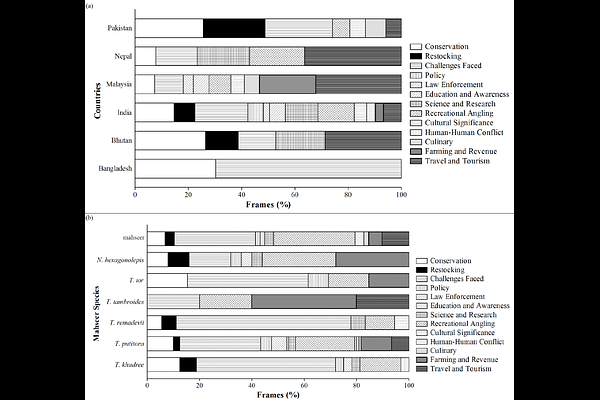'Crafting Fishy News': Framing and Attitudinal Positioning in English Newspaper Articles on Mahseer from Their Endemic Range

'Crafting Fishy News': Framing and Attitudinal Positioning in English Newspaper Articles on Mahseer from Their Endemic Range
Das, P.; Binoy, V. V.
AbstractWith the capacity to influence readers\' knowledge, emotions, attitudes and behaviours, newspapers play a pivotal role in conservation. We studied framing strategies and attitude positioning in articles published from January 2000 to April 2024 on mahseer, a group of freshwater fishes (56 species), by English-language newspapers from 17 nations that fall within their distribution range. However, we had to restrict our analysis to 6 nations (Bangladesh, Bhutan, Nepal, India, Pakistan and Malaysia) and 6 mahseer species (Tor khudree, T. putitora, T. remadevii, T. tor, N. hexagonolepis, and T. tambroides) due to the limited availability of substantial number of articles from other focal nations. A major share (79%) of the articles came from India, and T. putitora was the species that received the maximum attention from the newspapers (39%). Our result revealed a clear demarcation between the South-East Asian nation of Malaysia and the countries from South Asia, as well as between articles on mahseers native to these two different geographical regions, in terms of headline and text framing, choice of messengers and images, and attitude positioning in the news items. Dailies from South Asia largely employed conservation, environmental challenges and re-stocking efforts frames and promoted nature-centric, ecological and religio-cultural attitudes. By contrast, newspapers from Malaysia and the articles covering mahseer from this nation, T. tambroides reflected utility-centric and recreational framing and attitudes emphasising economic aspects. In general, episodic framing was more common than thematic, and instances of incorporating visual representations (with India as an exception) and positioning information on mahseer in the persuasive sections (exception - Nepal) were limited across focal nations and species. Our study also revealed that GenAI based Large Language Model (LLM ChatGPT 4) and Natural Language Processing (NLP) based tools (Hugging Face transformers) can be utilised as effective complementary or collaborative research tools alongside traditional manual qualitative data analysis to comprehend the framing and attitude positioning in the conservation news. Our results may help contextualise the communication strategies for conserving mahseers in South and South-East Asia, and also elucidate dimensions that need to be made salient for strengthening the connection between media and society for this purpose.